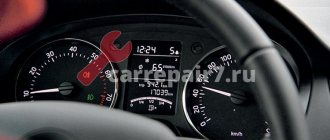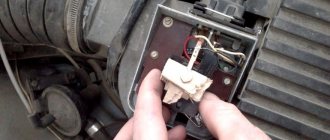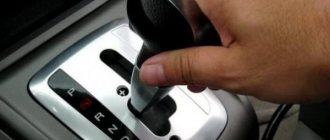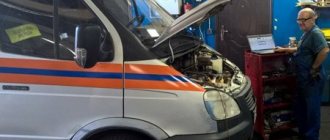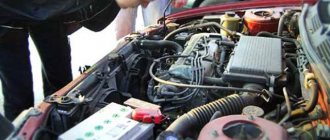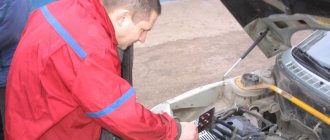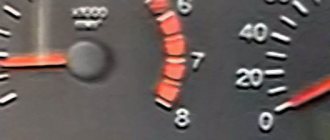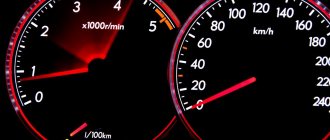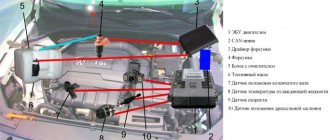A fairly common situation during the operation of a vehicle is when failures occur when pressing the gas pedal, the engine stalls when over-accelerating, the power unit does not pick up speed, choke, etc.
We also recommend reading the article about why the engine does not pick up speed. From this article you will learn about the reasons why the power unit responds to pressing the gas pedal with a delay or does not develop power.
Let's start with the fact that there can be many possible reasons for this type of malfunction. In the process of initial diagnosis, an important condition is the observation of characteristic symptoms, which allows you to more accurately and quickly determine the malfunction. Next, we will look at why the engine stalls when you press the gas pedal, as well as in what cases the engine stalls when you press the gas.
Failure when pressing the gas pedal: causes and solutions to the problem
Failure when pressing the gas pedal or accelerator pedal is a problem that is rare in modern cars, but a common occurrence in VAZ cars. The problem is that pressing the pedal has no effect. And after a few seconds there is a jerk, the car jerks. A serviceable engine responds quickly to pressing the gas pedal.
If you find such a problem in your car, do not put off fixing the problem until later. You can diagnose the problem yourself, but the best option would be to contact a car service. Mechanics with extensive experience and modern equipment will quickly find the cause of the gas pedal failure.
In winter, especially on slippery roads, sudden acceleration of the car can turn into a serious problem. In case of loss of control, an emergency situation may occur.
Failure while overtaking a passing vehicle on the road does not bode well. You will have to apply sharp braking and return to your lane, but there may be another car there.
ECM sensors
Currently, all modern cars are equipped with various electronic sensors, the data from which is read and sent to the engine control unit. After that, the ECU, depending on the received data, adjusts the engine operation. All this is necessary for more efficient engine operation, optimal fuel consumption, and power.
For example, such measuring devices include:
- Sensor that determines the concentration of oxygen in exhaust gases;
- Coolant temperature sensor;
- Mass air flow sensor;
- Knock sensor;
- DPKV;
- TPDZ and many others.
Incorrect operation of one of them can affect the power and throttle response of the engine, its fuel consumption, as well as its service life; in the worst case, the engine will simply refuse to work.
What are failures?
Failure when pressing the gas pedal lies in the improper reaction of the engine to this. Thus, when trying to accelerate, the engine does not gain the required speed.
This leads to a drop in speed. It manifests itself with gradual and sudden acceleration. Dips appear when you press the gas pedal in different ways:
- Short-term failures. There is no response to pressing for a couple of seconds.
- Lingering failures. The engine loses speed for 4 to 10 seconds, and it is possible that the car will stall.
- Jerks. Dips up to 1 or 2 seconds. The car seems to be “twitching”.
- A series of jerks. The engine either increases speed or slows down, although the pedal is in the same position.
- The car jerks. Consists of a series of protracted failures.
Symptoms of poisoning and first aid
The worst thing about carbon monoxide poisoning is that it happens unnoticed. CO does not have a distinct odor; its effects begin to be felt only through already quite serious symptoms in the form of headache, deterioration of health, nausea, vomiting, dry cough, encephalopathy (shaky gait), and inappropriate behavior. If this stage has passed, then the next one comes - sleep, and then there is practically no way to save yourself. After loss of consciousness, death can occur within 30 minutes.
The toxic effects of carbon monoxide depend on two quantities:
- concentration (i.e. the amount of CO in the inhaled air),
- exposure (i.e. how long a person was exposed).
At the initial stage, a person’s vision, hearing, and motor skills are impaired. With prolonged exposure, a coma develops and the person loses consciousness. If the exposure continues, then an irreversible process of death of brain cells begins, disruptions in the respiratory system, and heartbeat disturbances.
In case of prolonged exposure, various neurological disorders and brain hypoxia (a condition when some brain structures no longer function) are possible. People cannot speak, are not aware of themselves, paralysis is possible, and the person may remain mentally disabled.
Keep in mind that everyone experiences the effects of carbon monoxide differently. This depends both on the person’s weight, his proximity to the source, and on how easily he succumbs to carboxy. Children are more susceptible to the effects of CO.
HAVE YOU FOUND YOUR REASON?
Often, failures occur due to a breakdown of the power system. After pressing the gas pedal, the power system increases the volume of fuel supplied to the cylinders. Breakage causes a change in these proportions. Those. The motor just can't do its job.
In addition, it is possible that there may be a breakdown in the ignition system. It occurs much less frequently. It's either spark plugs or ignition wires. The spark plugs must be removed and checked. The presence of carbon deposits or too clean spark plugs indicate a rich or lean fuel mixture, respectively. This indicates that the ignition system is adjusted incorrectly.
To ensure that the fuel mixture ignites at the right time, read the article on how to set the ignition correctly.
Gas distribution mechanism
Incorrect adjustment of the valve timing or various malfunctions in the operation of the timing belt lead to the fact that the opening of the intake and exhaust valves occurs untimely. Because of this, exhaust gases from the combustion chamber may not be completely removed, or the chamber will not be completely filled with air or the fuel mixture.
In both cases, you can observe the following unpleasant signs:
- Problems with startup and in almost all cases;
- Unstable motor operation;
- Significant reduction in engine power, the car does not pull;
- The engine stalls quite often;
- In the most severe cases, the engine may simply seize.
If problems with speed appear after replacing the timing belt or chain, most likely the problem is due to incorrect installation of the teeth or belt tension. Even if no repair work has been carried out recently, it is worth checking the condition of the belt, as well as the correct settings of the timing marks, in order to exclude the possibility that the belt has jumped a certain number of teeth relative to its original position.
It is worth knowing that engine power can drop significantly due to incomplete opening, closing or damage to the timing valves. This can occur either due to incorrect valve settings or as a result of various malfunctions in the engine.
Dips when pressing the gas pedal during acceleration
Determined using computer diagnostics or the steps described below:
- The first thing you need to do is inspect the spark plugs. To do this you need to remove them. The presence of carbon deposits on the spark plugs, poor contact with the wires, or an excessively lean or rich mixture lead to spark plug malfunctions.
- High voltage wires can also cause engine malfunction, as can ignition coils.
- The throttle needs to be checked. If it is clogged, this causes the engine to respond untimely when pressing the gas pedal.
- It is necessary to check the condition of the air, fuel and oil filters. They tend to get clogged, which worsens dynamics, increases fuel consumption and causes pedal failure. They need to be changed constantly, you can do it yourself, they are inexpensive and easy to install.
- The presence of errors in the ECU leads to failures.
- Clogged injectors. If necessary, replace or repair injectors.
The wires, as well as the rubber bands on them, should not be damaged and should not spark when the engine is running. If damage is found, this indicates that the engine is shaking and jerking begins. This may occur due to the age of the car, worn-out or low-quality spare parts, poor contact with the spark plugs, or due to the temperature of the engine.
The resistance of the coils and the temperature change together, as a result of which a gasoline car begins to jerk during acceleration. In diesel cars, jerking cannot be associated with the coils, since they are not present.
First aid for CO poisoning
First of all, you need to get the person out into the fresh air. Carboxy is not in a strong connection with hemoglobin; it is quickly detached under the influence of simple atmospheric oxygen. If a person has been in a poisoned atmosphere for a short time, he can return to normal.
If the exposure was prolonged, then the victim urgently needs specialized help. First of all, you need to establish external breathing. Otherwise, a vicious circle will arise: the person breathes poorly, the effect of the poison increases, and breathing becomes more difficult. In a medical institution, artificial ventilation of the lungs is performed; if the victim is still breathing, he is placed in a pressure chamber. If little time has passed, a person may come to his senses after being placed in a pressure chamber.
The threshold for carbon monoxide poisoning is 20 mg/m³.
| CO concentration, mg/m³ | Duration of exposure | Symptoms of poisoning |
| 3 | 3 hours | Decreased accuracy of visual spatial perception and night vision |
| 6 | 25 min | Decreased color and light sensitivity of the eyes |
| 50–60 | 3–5 hours | Hearing loss, ECG changes |
| 80–100 | 3–5 hours | Reduced speed of visual perception, deterioration of motor coordination and analytical thinking |
| 440–460 | 1 hour | Pain in the forehead, throbbing in the temples, dizziness |
| 880 | 2 hours | Loss of consciousness, collapse |
| 1300–1700 | 1.5–3 hours | Increased breathing and heart rate, convulsions, coma* |
| 1800 | 20 minutes | Dizziness, coma |
| 1800–2300 | 1–1.5 hours | Decreased breathing and cardiac activity. Death may occur* |
In addition to carbon monoxide, other equally dangerous substances may be present in car exhaust:
Dips when pressing the gas pedal at idle
Problems also occur at idle speed; of course, there will be fewer reasons. However, this is also a serious problem and cannot be ignored, because... The car will have difficulty starting and simply stall.
Troubleshooting is performed in the following order:
- The first thing to check is the spark plugs. If the spark plugs are faulty, they should be replaced. We recommend replacing all spark plugs at the same time. Buy spark plugs specifically for your engine. If necessary, adjust the gap; it should be 1 mm for 92 gasoline.
- The fuel filter and fuel pump diagnostics are checked. If a malfunction is identified, fix it.
- The breakdown may be in the idle speed sensor.
- Checking the injectors. If clogged, replacement or cleaning is necessary.
- Diagnostics of the ECU for errors.
- Checking the injector.
A little about the Solex carburetor
Initially, VAZ equipped its cars with carburetors of the Weber family. These carburetors were completely mechanized. They lacked any electrical wiring and were not very reliable. Practically, they constantly needed attention, since the main struggle of car owners was aimed at returning the engine to idle speed. Only rear-wheel drive cars of the Zhiguli family VAZ 2101, 2103 and 2106 of the early versions were equipped with it.
“Weber” was replaced by “Ozone”, which began to be successfully used on VAZ 2105-07 cars. It was a perfect design, which was equipped with idle economizers and an autonomous system. The idle problem has been resolved. Ozone was also used on Niva cars.
With the advent of the front-wheel drive VAZ 2108 on the assembly line, a perfect design was required, aimed at reducing exhaust toxicity and maximizing fuel economy. This is how Solex was born.
Initially, it was a French design, which was purchased under license and was successfully installed not only on Samaras, but also on Zhigulis. Its design took into account all the mistakes of previous units, and efficiency increased to the limit. A properly tuned mechanism lasts a long time, and maintenance and repairs are cheaper than many modern cars. Unlike the Ozone family, it uses a long rod drive or cable, which significantly softens the accelerator pedal when depressed.
Almost all domestic carburetors are called DAAZ, and an index is written through a dash, the beginning of which corresponds to the car model.
Dips when pressing the gas pedal - carburetor
As noted above, the problem occurs in VAZ 2107, 2106, 2109 cars that have a carburetor installed. Mainly problems with the fuel system. It will most likely be clogged. Therefore, to identify the cause, the fuel supply to the carburetor is checked.
As a result of clogging, the operation of the fuel pump decreases, and the carburetor begins to receive less fuel. As a result, the engine starts and idles without problems, but when pressed, failures occur.
If everything is fine with the fuel system, then the fault must be looked for in the carburetor. It is responsible for dosing the supplied fuel into the air flow. If there are violations, failure occurs. However, first you need to check for air leaks. The carburetor may become loose, allowing air to leak through the gap, making the mixture lean.
The filter mesh must also be checked. It is located in the inlet fitting of the pipeline that goes to the fuel pump. If it is contaminated, then this is a consequence of failures.
Dips when pressing the gas pedal on the carburetor:
Checking the fuel pump
The main indicator of the performance of the fuel pump is the gasoline pressure in the fuel rail. Methods of connecting to the fuel line:
- using a standard fitting to measure pressure in the rail. This type of power system is installed on VAZ 8-valve internal combustion engines with a fuel return line from the rack to the gas tank. You can connect the pressure gauge through an adapter that screws onto a fitting with an external thread. Inside the fitting there is a spool valve, reminiscent of a bicycle valve, which, when pressed, communicates with the fuel rail and pressure gauge hose. But not all cars have a factory connector for connecting a pressure gauge. And in some cases the adapter itself is more difficult to find than to make a device for direct connection;
- connection contrary to the fuel line. You will need: a pressure gauge with a measurement scale of up to 7 kg/cm², a fuel hose of a suitable diameter, a tee and 2 fittings (“male” and “female” quick-release type) for connecting standard pipes. Such a simple device will allow you to crash into the fuel line, while maintaining the ability to start the engine.
There are a large number of ready-made kits for measuring fuel pressure in the rail on sale. But purchasing it is not practical for one-time use. The high cost is due to the many different fittings and adapters for connecting to the main types of power systems. If you are considering purchasing such a kit, make sure that it has the necessary adapters to connect to your car.
Dips when pressing the gas pedal - injector
To determine the reasons for the failure of the gas pedal of a raspberry with an injection engine, special equipment is needed, with the help of which diagnostics are carried out. Therefore, to detect a malfunction, you should definitely contact a car service in Moscow.
For the most part, jerking occurs when the fuel supply pressure is low or due to problems with the throttle position sensor.
We measure the pressure with our own hands
Before connecting to the fuel line, it is necessary to relieve the residual pressure in the system. To do this, just pull out the fuel pump fuse with the engine running. When the engine stalls, you can return the fuse and get to work. Let's move on to methods for measuring fuel pressure in the rail.
- Measurement with ignition on. The pressure gauge needle should rise rapidly and freeze in the normal pressure range. If after turning off the ignition arrow the pressure drops rapidly, the RTD on your car is faulty.
- Measurement with the engine running. The pressure gauge needle should not twitch or show less pressure than the lower limit of the standard values.
- Measurement with the ignition on and the return line pinched. In this case, the pump presses “against the wall” as much as possible.
If your car stalls when cold when you press the gas, perform diagnostics on a cold engine
It is important to simulate the conditions under which the symptoms of a malfunction appear most often
The pedal falls when the car starts to move
All unpleasant sensations are most often associated with a delayed reaction of the motor to pressing the pedal. Engine stalling often occurs.
The shocks appear when the throttle valve opens, then the sensor gives a signal and the ECU determines at what time to switch from idle to load mode, as well as how much to increase the fuel supply through the injectors. If the pressure is not as high as we would like, and if the injection time is increased, then there will not be enough fuel to move the car.
Also, the cause of jerking may be problems with the electromechanical part of the unit and due to clogging with waste.
Messages 11
1 Topic from G_E_N_A_1988 2016-04-13 19:18:25
- G_E_N_A_1988
- Participant
- Inactive
- Registration: 2013-10-07
- Messages: 148Thanks: 14
- Car: VAZ 21102
Topic: The car seems to choke if you press the gas hard
Good day! I have a VAZ 2110 8 valve injector. I started to do nonsense, you press the gas pedal suddenly, the car seems to choke, but if it’s quietly then it’s fine, it’s not comfortable to drive out in pavarots at all and the car doesn’t really drive. tell me the reason?
2 Reply from OlegD 2016-04-13 21:51:42 (2016-04-13 21:52:20 edited by OlegD)
- OlegD
- Connoisseur
- Inactive
- From: Moscow
- Registration: 2014-01-15
- Messages: 511Thanks: 115
- Car: 21114, door 21124 1.6 l., 2007 onwards
Re: The car seems to choke if you press the gas hard
The first thing that comes to mind is that the fuel pressure may not be enough. I would advise checking this first.
Then the symptoms are very similar to misfires. As I understand from the next topic, there is no BC. The check doesn't light up? What is the further development of events? You press the gas, it stalls, and then it drives normally?
3 Reply from Sergey VAZ 2111 2016-04-13 21:53:04
- Sergey VAZ 2111
- Connoisseur
- Inactive
- Registration: 2013-11-21
- Messages: 513Thanks: 145
- Car: VAZ 2111
Re: The car seems to choke if you press the gas hard
TPDZ. RXX. DMRV. FUEL PRESSURE.—————— Some of this is tricky.
4 Reply from sergo9531 2016-04-13 23:05:05
- sergo9531
- Local
- Inactive
- From: Domodedovo
- Registration: 2014-01-12
- Messages: 578Thanks: 208
- Auto: 21114
Re: The car seems to choke if you press the gas hard
G_E_N_A_1988, check the anti-drip glass in the tank
5 Reply from G_E_N_A_1988 2016-04-17 12:22:58
- G_E_N_A_1988
- Participant
- Inactive
- Registration: 2013-10-07
- Messages: 148Thanks: 14
- Car: VAZ 21102
Re: The car seems to choke if you press the gas hard
bk no, the check is not lit, very slowly but accelerates
Do you want to say that the glass has fallen off and there is not enough fuel? I would agree if the car was on its side, but on a flat surface the same thing happens
6 Reply from sergo9531 2016-04-17 18:30:52
- sergo9531
- Local
- Inactive
- From: Domodedovo
- Registration: 2014-01-12
- Messages: 578Thanks: 208
- Auto: 21114
Re: The car seems to choke if you press the gas hard
G_E_N_A_1988, the tank is relatively flat, when accelerating (in any direction) gasoline flows from the gas intake, and the pump sucks air. You can check this way: fill the tank full. If you stop being clever, then a glass)
7 Reply from G_E_N_A_1988 2016-04-17 19:14:12
- G_E_N_A_1988
- Participant
- Inactive
- Registration: 2013-10-07
- Messages: 148Thanks: 14
- Car: VAZ 21102
Re: The car seems to choke if you press the gas hard
8 Reply from pokemon1024 2016-04-17 22:23:26
- pokemon1024
- Participant
- Inactive
- From: Samara
- Registration: 2015-12-22
- Messages: 28Thanks: 16
- Car: VAZ-21113
Re: The car seems to choke if you press the gas hard
G_E_N_A_1988, If possible, connect to your brain and look in the same opendiag for sensors and, well, errors (there is an article on adapters on the site.) Just a couple of days ago something similar happened - the DPZ showed 82% at a closed throttle. Replaced it and all the problems went away. Which sensor is better to choose, again in the survey on the website.
The pedal falls when the movement is set
The cause may be a faulty ignition. In this case, diagnostics and repair work are required.
You can try to fix the problem yourself:
- First, you need to look under the hood and inspect everything. Remove the key from the ignition and check whether the ignition coils are securely attached and seated on the spark plugs. Next, start the engine and listen to how it works.
- Replace spark plugs regardless of their condition and how long they last. Check the spark plugs - if they are damaged, engine repair is inevitable.
The gas pedal fails in a VW POLO sedan due to unstable operation of the damper position sensor, which is built into the cover itself. The engine idles intermittently, the engine power is reduced to a minimum - this all indicates that the sensor has failed.
The cover itself cannot be disassembled, so you will have to replace the entire throttle assembly.
ECU - electronic control unit
In rare cases, the cause will be incorrect operation of the computer itself. The correct values may be received from the sensors, but the system will process them incorrectly and, accordingly, set the wrong ratio in the air-fuel mixture. In such cases, the driver is unlikely to be able to do anything on his own. The only way out is to go to a service center and conduct a thorough computer diagnostic.
In the rarest cases, it may be the hardware that is faulty. Here, software adjustment may not help, so you will have to replace the entire electronic control unit. Never neglect computer diagnostics. Most of the reasons are related precisely to the incorrect functioning of the “brains” of the car. Even experienced drivers with specialized equipment and software cannot always identify the source of such drops in speed.
Now you know all the possible reasons why engine speed drops when you press the gas. Do not delay solving this problem. The car may stall at the most inopportune moment, leading to a possible traffic accident. Incorrect operation of the computer or sensors will definitely lead to a number of other problems. Save on their repairs by quickly identifying faults.
DON'T POSTPONE YOUR CAR DIAGNOSIS FOR LATER!
If the failures do not stop, then you should definitely contact a specialist. They will be able to diagnose the computer control and check the fuel supply system and determine the location of the breakdown and carry out corrective measures. Most often, the cost of repairs is low. Therefore, the best advice would be not to do it yourself and entrust your car to professionals. This will be the most reasonable decision rather than wasting time, effort and nerves on troubleshooting yourself.
Didn't find the information you are looking for? on our forum.
Ignition system malfunctions
When the throttle valve is opened sharply, the breakdown voltage between the spark plug electrodes increases. Therefore, defects in the operation of the ignition system primarily appear when driving under load and sharply pressing the gas pedal. Possible causes of engine failures and unstable operation:
- A combination of bad spark plugs, damaged insulation of high-voltage wires, cracks in the ignition coil housing.
- The ignition timing is set incorrectly. Often in this case, a knocking sound is heard in the engine when you press the gas, which is lumbago due to untimely combustion of the air-fuel mixture.
- Accumulation of moisture under the distributor cover, incorrect clearance on the cams.
- Hall sensor defective.
- Failure of the centrifugal regulator UOZ.
- Malfunction of the vacuum ignition timing regulator. If you suspect a faulty VROZ, first check the tightness of the vacuum line. Cracks in the tubes, loose fitting on the fittings, or a diaphragm breakthrough lead to a vacuum leak and a lack of automatic adjustment of the pressure control when the accelerator pedal is pressed.
